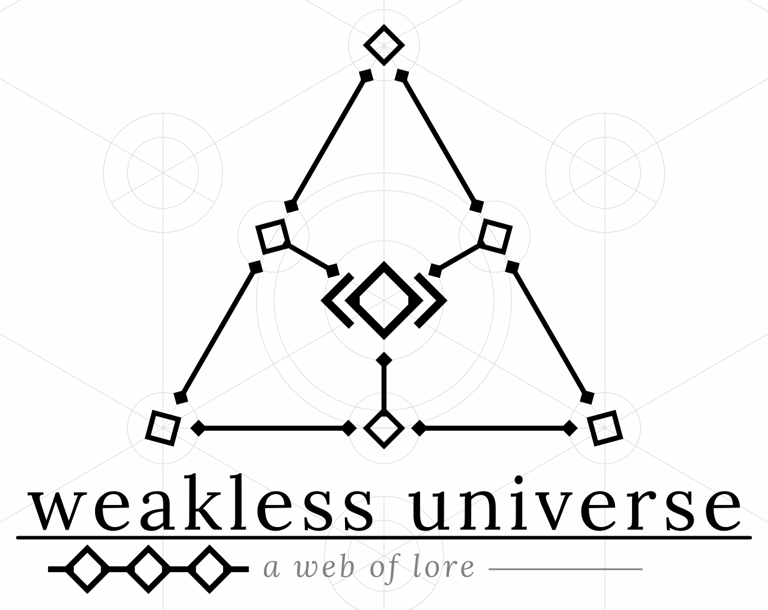
weakless universe - Five Minutes, Not 5e Transcript
The transcript for Entry 2 of Five Minutes, Not 5e: weakless universe from Deric Bindel.
GM-LESS GAMESTTRPGSFIVE MINUTES, NOT 5E
Daniel Copper
7/4/20254 min read



The cover of weakless universe by Deric Bindel, Arlyn, Giovanna and Rat With Scarf



Transcript
DANIEL COPPER: Welcome back to Five Minutes, Not 5e! My name is Daniel [Copper], otherwise known as the Copper Compendium, and I’ll be your host! Here, I chat with the designers of lesser-known tabletop role-playing games about games they created, drilling down into the core of what makes their game tick. I’m joined today by Deric Bindel. Would you like to introduce yourself, and the game we’ll be chatting about today?
DERIC BINDEL: Hi, I’m Deric, I go by zey/zem, and I was one of the four designers on the game weakless universe, a game where the players craft a conspiracy-board-style web of lore, starting with a mysterious central event, radiating out adding groups, artifacts, rituals and more, until the group finally learns what the central event at the heart of everything is.
DANIEL: What genre is the game, and what are some relevant cultural touchstones?
DERIC: weakless universe is a worldbuilding game, meaning that the players work together to create a new setting or flesh out some aspect of an existing world. With regards to story genre – is it sci-fi, fantasy or something else – that is determined by the group while setting up the game; there is a list of some sample settings and genres that the players can use, or they can go off in their own direction. Touchstones range from Neon Genesis Evangelion, Kingdom Hearts, Stephen King’s Dark Tower series, Homestuck, Lord of the Rings – basically anything with a lot of groups, events, and esoteric names.
DANIEL: How many players is it for, and how long does it last?
DERIC: It is for three to four players, with a typical game running from one to two hours, concluding within a single sitting. All players are on the same level – no one has any special actions or privileges over the others during play.
DANIEL: What do you need to play, and how quickly can you learn?
DERIC: The players need a shared space where they can all see, write and draw on, either digitally or in person. I’ve only played this game online but I’ve heard that it can be a blast to play with actual sticky notes, push pins, [and] string on a proper corkboard. Based on my experience with new players and on feedback from others, people typically pick up the rules fairly quickly, usually within about five to ten minutes, once they’ve had a chance to play. There aren’t many actions that a player can take and there are very few things that they have to juggle or keep track of during play.
DANIEL: What might a typical session involve?
DERIC: Seeing as this is a single session game, I’ll break down what play is like from turn to turn. Players start out with a number of tokens and each turn they one of those tokens to add something to the board, to connect existing items on the board or to define something when it has enough connections, meaning they declare what that something is in the world that they’ve created.
This is the meat of the game – players will be coming up with new names, new ways for things to share connections (and what those connections are) and then putting all that together when defining those items. There’s a strong focus on player creativity throughout all aspects of play.
DANIEL: How have you made it accessible to beginners, and people with specific needs?
DERIC: As the game is somewhat esoteric when just read, a number of example games are also provided to give players an idea of what completed play looks like. For example, something that routinely came up with new players is a difficulty in feeling out how out-there or strange they could get with connections or definitions, and seeing the example games really helps them feel comfortable going for it and getting strange with it.
DANIEL: Thanks, Deric, for chatting with me about weakless universe! I hope this interview helped those of you listening get to grips with the game’s themings and play, and I look forward to hearing from those of you who check the game out!
Where can people find you and your games, Deric?
DERIC: You can find me on Bluesky and Tumblr, both @dericbindel, one word, on each. This game and my own games can be found on my itch.io page. I also wanna give a big special thanks to my friends and fellow designers Arlyn, Giovanna, and Rat With Scarf, without whom this game would not have come together.
DANIEL: You can find those links, as well as links to the transcript of this entry and links to the game, in the video description [below, here]. If you want to find games with similar themes or gameplay to this one, there will also be links to relevant playlists.
And that rounds out this entry of Five Minutes, Not 5e! If you want to hear me chat further with Deric about weakless universe, check out the Beyond Five Minutes episode where we’ll delve into inspirations for the game, the design process and zeyr favourite connections. Until then, thanks for listening, until next time!
[End of transcript.]

Links
The Game and its Designer
Get the game: https://dericbindel.itch.io/weakless-universe
Check out Deric's games on itch.io: https://dericbindel.itch.io/
Follow Deric on Bluesky: https://bsky.app/profile/dericbindel.bsky.social
Follow Deric on Tumblr: https://www.tumblr.com/dericbindel
Relevant (YouTube) Links
weakless universe - Beyond Five Minutes: https://youtu.be/Odl9FOwtAxM
weakless universe - Beyond Five Minutes Transcript: https://thecoppercompendium.co.uk/weakless-universe-beyond-five-minutes-transcript
Single-session: https://www.youtube.com/playlist?list=PLsLJ-CI8A8CCvMCwKjot2cwDzU1vDw35U
Without A Guiding Player: https://www.youtube.com/playlist?list=PLsLJ-CI8A8CAd6O-NXiFRkooGlQ-cMieR
Worldbuilding: https://www.youtube.com/playlist?list=PLsLJ-CI8A8CBwyCBtcb7E_zzCXcc9fNez

